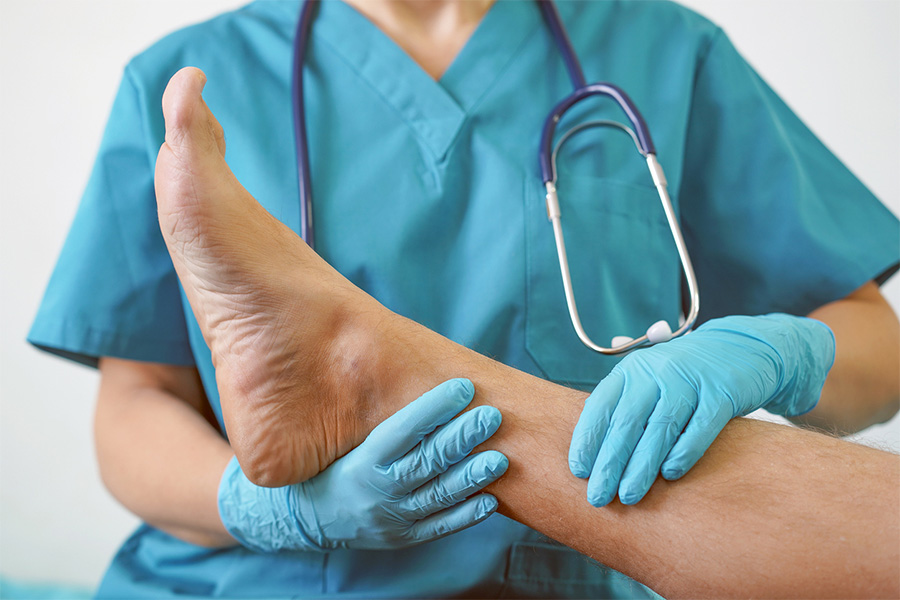Peripheral artery disease (PAD) can compromise the blood circulation in your arms and legs due to plaque buildup in the artery walls. The condition often causes severe leg pain and other debilitating symptoms, because the arteries carry blood from the heart to the various organs and cells throughout the body – and when blood flow is impeded, it can cause chronic pain.
The legs and feet are particularly susceptible to blood flow issues because they are farther away from the heart. Extra force is necessary to successfully push fresh blood through the arteries, so it is important that these blood vessels are clear and open. In arterial disease, cholesterol plaques form inside the artery walls and slow down blood flow.
Fortunately, there are many treatment methods that doctors can employ to resolve arterial disease. Let’s talk about some of those methods and who you can see for a medical evaluation and treatment.
Medications for Arterial Disease
Many people with peripheral artery disease benefit from taking certain types of medicine, including the following:
Cholesterol Medication
A standard treatment for arterial disease is to prescribe cholesterol-controlling medication. These medications act to reduce your levels of low-density lipoprotein (LDL), which is the “bad” cholesterol that tends to stick to the blood vessel walls. By lowering your LDL cholesterol levels, you can help to keep your arteries open and not blocked.
Diabetes and Hypertension Medications
If you have other diseases that could affect the cardiovascular system, such as diabetes or high blood pressure, then taking medication to treat these underlying issues can help to mitigate arterial disease as well. Diabetes involves high levels of glucose in the blood, and high blood pressure (hypertension) involves too much force being applied to the vascular walls, so it is especially important to keep these conditions under control if you also have arterial disease in order to prevent a combination effect.
Anti-Clotting Medication
Your doctor might also prescribe anti-clotting medicine that can help to prevent blood clots from forming in your arteries and thereby creating blockages. These drugs help to increase blood flow, which can alleviate symptoms such as the following:
- Foot and leg pain
- Numbness
- Weakness
- Poorly healing wounds on your foot or leg
- Cold or discolored feet
Lifestyle Changes
Another crucial part of your treatment plan is to adopt healthy habits. Given that your arteries are already compromised, it becomes even more essential to follow a lifestyle that would make your cardiovascular system more robust.
Smoking can promote the further narrowing of your blood vessels, so it is strongly recommended to quit if you have arterial disease. Your doctor may also prescribe an exercise program you enjoy in order to foster better circulation. Over time, exercise can increase the blood flow to your extremities, potentially resolving your vascular issues.
Angioplasty
More advanced cases of arterial disease might require surgical correction. A typical procedure to fix PAD is an angioplasty, whereby surgeons physically widen the affected artery.
They accomplish this by carefully introducing a catheter into the affected segment of the blood vessel. It has a tiny expanding balloon at its tip, which is then inflated to gently open up and expand the artery.
Surgeons may also place a stent – a tube composed of fine metal mesh – into the area affected with cholesterol buildup. The stent remains in place, where it can support the artery walls and prevent them from collapsing. The stent may also have embedded medication that promotes healing.
Bypass Surgery for Arterial Repair
In bypass surgery, the surgeon will extract a vein from elsewhere in your body, such as your leg. The vein is then grafted in place of the area where there is plaque. Sometimes, surgeons may also use artificial (prosthetic) blood vessel grafts to enable blood circulation to bypass the compromised artery.
Arterial Disease Treatments in Cincinnati
If you are experiencing any of the symptoms mentioned above, schedule a consultation with one of our specialists at Cincinnati Foot & Ankle Care. We are equipped to identify your risk factors for peripheral artery disease and to diagnose its cause, whether it is due to an underlying condition or a vascular issue.
With offices conveniently located across the Cincinnati area, we offer a wide range of podiatric services for patients of all ages. If you have any questions or would like to schedule an appointment, call our office near you or fill out our handy online form now. We look forward to serving you!





